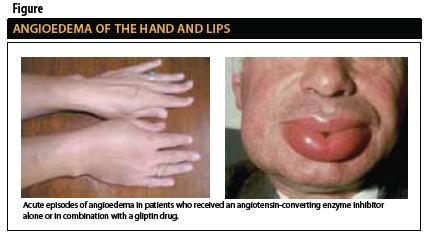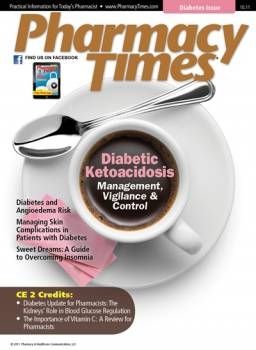Treatment of Diabetes and Angioedema Risk
Pharmacists must be aware of potentially serious adverse reactions in patients receiving angiotensin- converting enzyme therapy, particularly with the concurrent use of dipeptidly peptidase IV inhibitors.
Pharmacists must be aware of potentially serious adverse reactions in patients receiving angiotensin-converting enzyme therapy, particularly with the concurrent use of dipeptidly peptidase IV inhibitors.

Overview
Type 2 diabetes mellitus (T2DM) affects millions of human beings worldwide, and appears to be the most common cause of cardiovascular, neurologic, and renal disorders.1 A variety of insulins and antidiabetic drugs are used for the treatment of T2DM.
A recently discovered category of drugs, identified as dipeptidyl peptidase IV (DPP IV or CD26) inhibitors and also known as gliptins, are being increasingly prescribed for the treatment of T2DM.2 The enzyme DPP IV is a cell-surface peptidase that is expressed throughout the body tissues and is responsible for the degradation of incretin hormones, including glucagon-like peptide-1 (GLP- 1).3 The GLP-1 and other similar incretin peptides play an important role in glucose homeostasis.
Incretins help to maintain blood glucose to a normal level by slowing gastric emptying, suppressing glucagon production, and stimulating insulin release.3 Administration of a DPP IV inhibitor drug to a T2DM patient causes an increase in circulatory GLP-1 that leads to reductions in fasting glucose and hemoglobin A1C levels in the blood.4,5 A chronic administration of DPP IV inhibitor to patients with T2DM has also been reported to preserve mass of insulin producing beta-cells in preclinical studies.
In addition to degrading incretin peptides, DPP IV metabolizes many other physiologic peptides, including des-Arg 1 - bradykinin (metabolite released due to the activity of aminopeptidase-P on bradykinin) and substance P.6 Bradykinin is produced from circulatory kininogens, whereas substance P is released from the perivascular neurons.7,8 All 3 neuropeptides (bradykinin, des-Arg 1 -bradykinin, and substance P) are vasoactive and potent edema-causing agents.9 These peptides, once produced in vivo, are rapidly metabolized by an active enzyme, dipeptidyl carboxypeptidase or CD143 (commonly known as angiotensin-converting enzyme [ACE]).10 Like DPP IV, ACE is a cell surface peptidase, found in several body tissues, with highest concentration in pulmonary circulation.10
Table. Angioedema Risk-Associated Drugs
ACE Inhibitors
DPP IV Inhibitors
Benazepril (Lotensin)
Captopril (Capoten)
Enalapril (Vasotec)
Fosinopril (Monopril)
Lisinopril (Prinivil)
Moexipril (Univasc)
Perindopril (Aceon)
Quinapril (Accupril)
Ramipril (Altace)
Trandolapril (Mavik)
Linagliptin (Tradjenta)
Saxagliptin (Onglyza)
Saxagliptin Metformin (Kombiglyze)
Sitagliptin (Januvia)
Sitagliptin Metformin (Janumet)
Ace Inhibitor—Induced Angioedema
ACE inhibitors are well-known antihypertensive and renoprotective drugs. The number of patients receiving treatment with ACE inhibitors is growing rapidly. An increasing number of patients with diabetes is also being prescribed ACE inhibitors as a part of their treatment.
Parallel to an increase in the patient count on ACE inhibitor therapy, emergency department admissions because of ACE inhibitor—related adverse drug reactions (ADRs) are also increasing. Of the many types of ADRs that have been attributed to the initiation of ACE inhibitor therapy, angioedema is recognized as one of the most life-threatening.11,12
Although serious episodes of angioedema have been reported to occur in some patients even after several months of drug treatment, the likelihood of angioedema onset is considerably higher immediately following start of ACE inhibitor therapy.11,12 Indeed, the most severe episodes of angioedema have been reported to occur within a few hours following administration of the first dose of an ACE inhibitor.
ACE inhibitor—induced angioedema is most commonly characterized as swelling of the lips, mouth, tongue, and/or airways.12 An acute episode of angioedema often involves swelling of the skin, larynx, pharynx, and/or gastrointestinal mucosa. An inflammation and swelling of these tissues may be accompanied by itchiness in hands or elsewhere in the body. 12 Generally following ACE inhibitor therapy, an adverse episode may develop as a deep subcutaneous and/or submucosal edema (Figure). It may manifest itself as a self-limiting single event or transform into recurrent multiple episodes.
In some severe cases, life-threatening edema may engulf the oropharynx, requiring a nasotracheal intubation in order to maintain respiration.12 Failure to maintain adequate airway function via nasotracheal tube may trigger a need for an emergency tracheostomy. Approximately 5% to 16% of the patients with ACE inhibitor—induced angioedema require intubation or urgent tracheostomy.13 Other treatment measures following emergency department admission after ACE inhibitor—induced angioedema include an administration of intravenous antihistaminic drug (most commonly diphenhydramine) as well as treatment with corticosteroids. Angioedema treatment in these patients may also involve discontinuation of an ACE inhibitor and start of treatment with an alternate drug, such as an angiotensin receptor blocker.
DPP IV Inhibitor—induced Increased Risk
Under normal physiologic conditions, DPP IV—mediated degradation of bradykinin, des-Arg 1 -bradykinin, and substance P is less significant but becomes highly important in patients receiving ACE inhibitor therapy. During ACE inhibition (by enalapril, lisinopril, quinapril, or any other ACE inhibitor), kinins and substance P are slowly metabolized by DPP IV and some other enzymes. In fact, DPP IV becomes a primary enzyme causing metabolism of substance P during an inhibition of ACE.14
If a patient is concurrently receiving ACE and DPP IV inhibitors, not only is ACEmediated rapid metabolism of kinins and substance P suppressed, but the DPP IV—mediated slow degradation of these peptides is also blocked. As a result, these peptides may accumulate in the vasculature, and because of their high edema-causing biologic potency, 9 an exudation of plasma from the post-capillary venules into the tissues leads to the development of an interstitial edema in human patients.
Additionally, it had been demonstrated in animal studies that during ACE inhibition, if tissue and plasma activity of DPP IV is suppressed, the susceptibility to an onset of peritracheal edema is significantly increased.15 Accumulated data now demonstrate that a concurrent administration of ACE and DPP IV inhibitors appears to have an added risk for ADRs that may be associated with an angioedema response.16
In the past few years, 3 DPP IV inhibitors, linagliptin (Tradjenta), sitagliptin (Januvia), and saxagliptin (Onglyza), have been approved by the FDA for the treatment of T2DM as an adjunctive therapy to diet and exercise. Two of these DPP IV inhibitors are also available in combination with metformin under the names Janumet (sitagliptin plus metformin) and Kombiglyze (saxagliptin plus metformin). Two more gliptin drugs, alogliptin (Nesina) and vildagliptin (Galvus), are under review by the FDA and may get approval in the near future.
Among the abovementioned DPP IV inhibitors, linagliptin was approved by the FDA only a few months ago and thus post-marketing clinical safety data is yet to emerge. Prescribing information from the package insert of linagliptin indicates nasopharyngitis as the most common adverse effect.
Regarding safety data for the other 2 drugs, a post-marketing report of sitagliptin demonstrated an increased risk of onset of nasopharyngitis- and angioedema-like symptoms,17 and a pre-marketing report of vildagliptin appeared to show similar ADR data.16 According to the latter report, there was no direct correlation between vildagliptin use and angioedema onset while patients received this drug as monotherapy. However, there was a 4- to 5-fold increase in the risk of angioedema and nasopharyngitis onset when patients concurrently received ACE and DPP IV inhibitors.
Role Of the Pharmacist
The clinicians and pharmacists providing care to patients with diabetes and hypertension should remain alert about angioedema-related ADRs when their patients are receiving ACE inhibitors, and in particular if they are taking ACE and DPP IV inhibitors concurrently. Health care providers should take necessary steps to minimize risk of ADRs associated with therapy by these drugs. The monitoring and counseling of patients at the point of care following initiation of treatment is highly desirable and beneficial. The pharmacist is often the first health care provider to receive a phone call from the patient who may be developing angioedema symptoms.
A careful family history taken for angioedema before initiating treatment with an ACE inhibitor or an ACE inhibitor plus gliptin drug may be helpful. A mandatory requirement for the pharmacist of recording the patient’s family history as well as educating and counseling prior to the dispensing of ACE and DPP IV inhibitors may guide treatment in case an angioedema episode develops. These efforts by the pharmacist can certainly reduce treatment delays and fatality risks among patients who may experience angioedema-related symptoms following monotherapy with an ACE inhibitor or treatment with ACE plus DPP IV inhibitors. PT
Dr. Ahmad is an adjunct assistant professor of pharmacology at New York Medical College and a clinical pharmacist and pharmacologist at Harlem Hospital Center in New York, New York. Mr. Khan is director of pharmacy at Harlem Hospital Center in New York.
References
1. McFarlane SI, Banerji M, Sowers JR. Insulin resistance and cardiovascular disease. J Clin Endocrinol Metab. 2001;86:713-718.
2. McIntosh CH, Demuth HU, Pospisili JA, Pederson R. Dipeptidyl peptidase IV inhibitors: how do they work as new antidiabetic agents? Regul Pept. 2005;128:159-165.
3. Drucker DJ. Enhancing incretin action for the treatment of type 2 diabetes. Diabetes Care.2003;26:2929-2940.
4. Aschner P, Kipnes MS, Lunceford JK, Sanchez M, Mickel C, Williams-Herman DE. Effect of the dipeptidyl peptidase-4 inhibitor sitagliptin as monotherapy on glycemic
control in patients with type 2 diabetes. Diabetes Care. 2006;29:2632-2637.
5. Drucker DJ. Dipeptidyl peptidase — 4 inhibition and the treatment of type 2 diabetes:preclinical biology and mechanism of action. Diabetes Care. 2007;30:1335-1343.
6. Takagaki Y, Kitamura N, Nakanishi S. Cloning and sequence analysis of cDNAs for human high molecular weight and low molecular weight prekininogens: primary structures of two human prekininogens. J Biol Chem. 1985;260:8601-8609.
7. Russell JS, Chi H, Lantry LE, Stephens RE, Ward PE. Substance P and neurokinin metabolism by cultured human skeletal muscle myocytes and fibroblasts. Peptides. 1996;17:1397-1403.
8. Uddman R, Edvinsson L, Owman C, Sundler F. Perivascular substance P: occurrence and distribution in mammalian pial vessels. J Cereb Blood Flow Metab. 1981;1:227-232.
9. Emanueli C, Grady EF, Madeddu P, et al. Acute ACE inhibition causes plasma extravasation in mice that is mediated by bradykinin and substance P. Hypertension. 1998;31:1299-1304.
10. Ahmad S,Ward PE.Depressor action of bradykinin agonists relative to metabolism by angiotensin-converting enzyme, carboxypeptidase N, and aminopeptidase P
.
Proc Soc Exp Biol Med. 1992;200:115
-
121
.
11. Wood SM, Mann RD, Rawlins MD. Angioedema and urticaria associated with angiotensin converting enzyme inhibitors. BMJ. 1987;294:91-92.
12. Slater EE, Merrill DD, Guess HA, Roylance PJ, Cooper WD, Inman WHW. Clinical profile of angioedema associated with angiotensin converting enzyme inhibition. JAMA.
1988;260:967-970.
13. Brown NJ, Snowden M, Griffin MR. Recurrent angiotensin-converting enzyme inhibitor-associated angioedema. JAMA. 1997;278:232-233.
14. Ahmad S, Wang L, Ward PE. Dipeptidyl(amino)peptidase IV and aminopeptidase M metabolize circulating substance P in vivo. J Pharmacol Exp Therapeut. 1992;260:1257-1261.
15. Byrd JB, Shreevatsa A, Putlur P, Foretia D, McAlexander L, Sinha T. Dipeptidyl peptidase IV deficiency increases susceptibility to angiotensin-converting enzyme
inhibitor-induced peritracheal edema. J Allergy Clin Immunol.2007;20:403-408.
16. Brown NJ, Byiers S, Carr D, Maldonado M, Warmenr BA. Dipeptidyl peptidase-IV inhibitor use associated with increased risk of ACE inhibitor-associated angioedema.
Hypertension. 2009;54:516-523.
17. Amori RE, Lau J, Pittas AG. Efficacy and safety of incretin therapy in type 2 diabetes: systematic review and meta analysis. JAMA. 2007;298:194-206.

